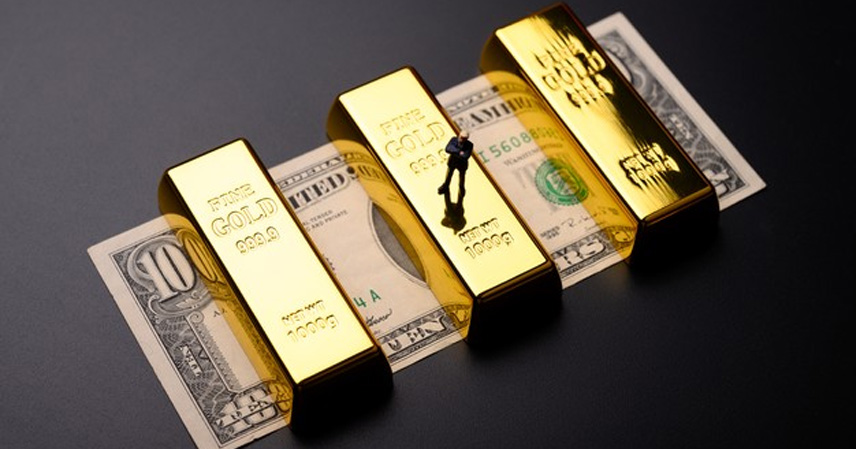After gold prices briefly broke the $4,000 mark, the U.S. financial establishment finally appeared to take action to defend the dollar’s credibility. As China’s markets opened, the U.S. dollar index suddenly surged, showing an unusual strength that many analysts suspect was not entirely market-driven.
By the end of October 9, international gold prices had dropped nearly 2%, falling back below $4,000 per ounce. The move sent ripples through global markets — speculative capital quickly shifted from trend-following to short-term trading, and even China’s A-shares opened lower on October 10 as funds exited risk assets.
The question now is: Does this sharp correction mean the gold rally is over — or is it simply a buying opportunity for those who missed the first wave?
The Dollar Faces Twin Blows
During China’s National Day holiday, two developments hit the U.S. dollar’s global dominance:
- BHP Group, the Australian mining giant, agreed to settle iron-ore transactions in Chinese yuan.
- Russia demanded that India pay for crude oil imports using yuan-denominated settlements.
Together, these moves weakened the dollar’s pricing power in both energy and raw-materials markets, two pillars of its global reserve-currency status.
The market’s reaction was swift: capital fled to gold as a hedge against monetary uncertainty. The logic was straightforward — as global trade transitions from a dollar-centric system toward a multi-currency anchor, gold has re-emerged as the neutral store of value everyone can trust.
For decades, nearly all commodities — from oil to metals — were priced relative to U.S. Treasury yields. Now, with the dollar’s authority eroding and neither the yuan nor the euro yet commanding full global confidence, gold is once again serving as the universal reference point.
China’s Gold Strategy and the Limits of RMB Internationalization
Despite aggressive accumulation, China’s official gold reserves remain modest by global standards. According to central-bank data, China’s gold share of total reserves rose from 3.9% in 2023 to 7.3% by August 2025. The increase is significant, but still below the international average of roughly 15%.
This shortfall limits the yuan’s full internationalization. While Beijing has captured part of the dollar’s trade share, the yuan is still a rising challenger, not yet a peer currency. Building trust — both from foreign governments and global investors — will take time, and gold holdings are a crucial credibility anchor in that process.
In short, the surge in gold and yuan valuations during the holiday dealt a heavy blow to dollar hegemony, but Washington still retains tools for counterattack.
Washington’s Counter-Move: Reviving Old Tricks
Historically, the U.S. has defended the dollar’s supremacy by suppressing gold prices through the paper-gold (futures) market. Massive institutional players, often with deep pockets, can flood the market with short positions far exceeding actual physical gold supply. Because these are paper contracts without physical settlement, the effect is to artificially depress gold prices — a tactic that has proven highly effective in the past.
However, years of such interventions have depleted America’s physical gold buffer. Many analysts argue that the U.S. no longer holds the gold reserves it claims, a suspicion reinforced by the abrupt end of former President Trump’s audit initiative.
With limited real gold, Washington’s options are narrowing. The latest strategy appears to be propping up the dollar index itself, even at the cost of pressuring its allies. Recent weeks have seen a sharp depreciation in the yen and the won, both of which appear to be collateral victims of America’s liquidity defense.
The short-term result? Gold’s pullback below $4,000 and a temporary boost to the dollar. But the underlying symptom — tightened global dollar liquidity — suggests deeper vulnerabilities.
A Fragile Victory for the Dollar
While the current rebound in the U.S. dollar index may look convincing, it still failed to break above the 100 threshold. Every time the dollar’s liquidity is artificially squeezed, the costs eventually return with interest. Allies like Japan and South Korea can only absorb so much pressure before their own foreign-exchange reserves and fiscal stability come under strain.
Thus, the recent correction in gold should be seen less as the end of the rally and more as a mid-cycle pause — a recalibration before the next wave. When the next crisis of confidence hits, gold’s climb could resume with even greater intensity.
For individual investors, institutions, and even central banks, each episode of U.S.-led gold suppression has historically proven to be a buying opportunity. The rise of gold is not merely a commodity story — it is a monetary transformation, signaling that the era of unchallenged dollar hegemony is nearing its twilight.
References
- Public data from the People’s Bank of China (PBoC)
- Market reports on BHP and Russia–India crude-settlement announcements
- Historical analyses of U.S. gold-futures market interventions



